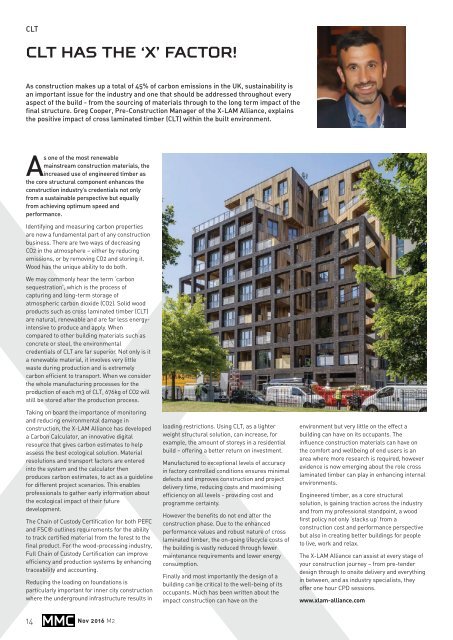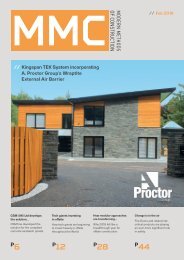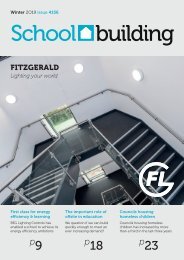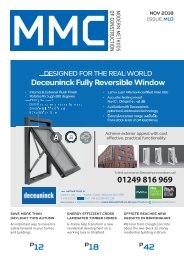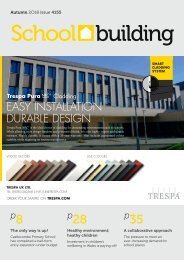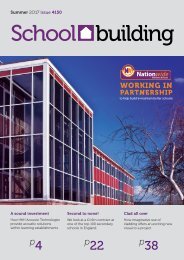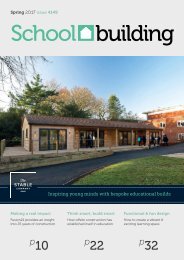M2 MMC Nov' '16 cc
Create successful ePaper yourself
Turn your PDF publications into a flip-book with our unique Google optimized e-Paper software.
CLT<br />
CLT has the ‘X’ factor!<br />
As construction makes up a total of 45% of carbon emissions in the UK, sustainability is<br />
an important issue for the industry and one that should be addressed throughout every<br />
aspect of the build - from the sourcing of materials through to the long term impact of the<br />
final structure. Greg Cooper, Pre-Construction Manager of the X-LAM Alliance, explains<br />
the positive impact of cross laminated timber (CLT) within the built environment.<br />
As one of the most renewable<br />
mainstream construction materials, the<br />
increased use of engineered timber as<br />
the core structural component enhances the<br />
construction industry’s credentials not only<br />
from a sustainable perspective but equally<br />
from achieving optimum speed and<br />
performance.<br />
Identifying and measuring carbon properties<br />
are now a fundamental part of any construction<br />
business. There are two ways of decreasing<br />
CO2 in the atmosphere – either by reducing<br />
emissions, or by removing CO2 and storing it.<br />
Wood has the unique ability to do both.<br />
We may commonly hear the term ‘carbon<br />
sequestration’, which is the process of<br />
capturing and long-term storage of<br />
atmospheric carbon dioxide (CO2). Solid wood<br />
products such as cross laminated timber (CLT)<br />
are natural, renewable and are far less energyintensive<br />
to produce and apply. When<br />
compared to other building materials such as<br />
concrete or steel, the environmental<br />
credentials of CLT are far superior. Not only is it<br />
a renewable material, it involves very little<br />
waste during production and is extremely<br />
carbon efficient to transport. When we consider<br />
the whole manufacturing processes for the<br />
production of each m3 of CLT, 676kg of CO2 will<br />
still be stored after the production process.<br />
Taking on board the importance of monitoring<br />
and reducing environmental damage in<br />
construction, the X-LAM Alliance has developed<br />
a Carbon Calculator, an innovative digital<br />
resource that gives carbon estimates to help<br />
assess the best ecological solution. Material<br />
resolutions and transport factors are entered<br />
into the system and the calculator then<br />
produces carbon estimates, to act as a guideline<br />
for different project scenarios. This enables<br />
professionals to gather early information about<br />
the ecological impact of their future<br />
development.<br />
The Chain of Custody Certification for both PEFC<br />
and FSC® outlines requirements for the ability<br />
to track certified material from the forest to the<br />
final product. For the wood-processing industry,<br />
Full Chain of Custody Certification can improve<br />
efficiency and production systems by enhancing<br />
traceability and a<strong>cc</strong>ounting.<br />
Reducing the loading on foundations is<br />
particularly important for inner city construction<br />
where the underground infrastructure results in<br />
14 <strong>MMC</strong><br />
Nov 2016 <strong>M2</strong><br />
loading restrictions. Using CLT, as a lighter<br />
weight structural solution, can increase, for<br />
example, the amount of storeys in a residential<br />
build – offering a better return on investment.<br />
Manufactured to exceptional levels of a<strong>cc</strong>uracy<br />
in factory controlled conditions ensures minimal<br />
defects and improves construction and project<br />
delivery time, reducing costs and maximising<br />
efficiency on all levels - providing cost and<br />
programme certainty.<br />
However the benefits do not end after the<br />
construction phase. Due to the enhanced<br />
performance values and robust nature of cross<br />
laminated timber, the on-going lifecycle costs of<br />
the building is vastly reduced through fewer<br />
maintenance requirements and lower energy<br />
consumption.<br />
Finally and most importantly the design of a<br />
building can be critical to the well-being of its<br />
o<strong>cc</strong>upants. Much has been written about the<br />
impact construction can have on the<br />
environment but very little on the effect a<br />
building can have on its o<strong>cc</strong>upants. The<br />
influence construction materials can have on<br />
the comfort and wellbeing of end users is an<br />
area where more research is required, however<br />
evidence is now emerging about the role cross<br />
laminated timber can play in enhancing internal<br />
environments.<br />
Engineered timber, as a core structural<br />
solution, is gaining traction across the industry<br />
and from my professional standpoint, a wood<br />
first policy not only ‘stacks up’ from a<br />
construction cost and performance perspective<br />
but also in creating better buildings for people<br />
to live, work and relax.<br />
The X-LAM Alliance can assist at every stage of<br />
your construction journey – from pre-tender<br />
design through to onsite delivery and everything<br />
in between, and as industry specialists, they<br />
offer one hour CPD sessions.<br />
www.xlam-alliance.com


